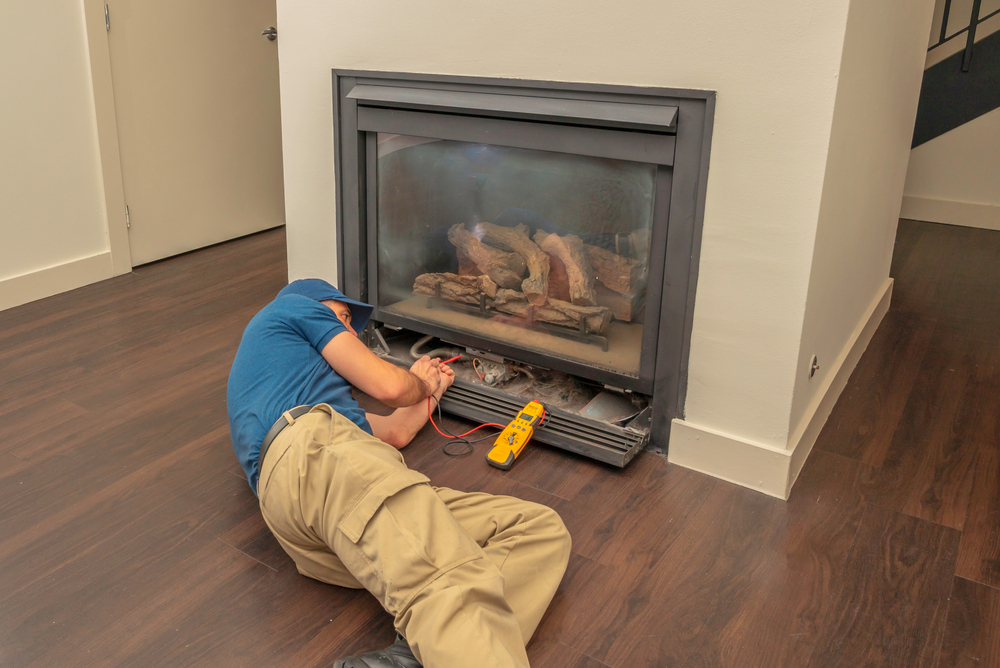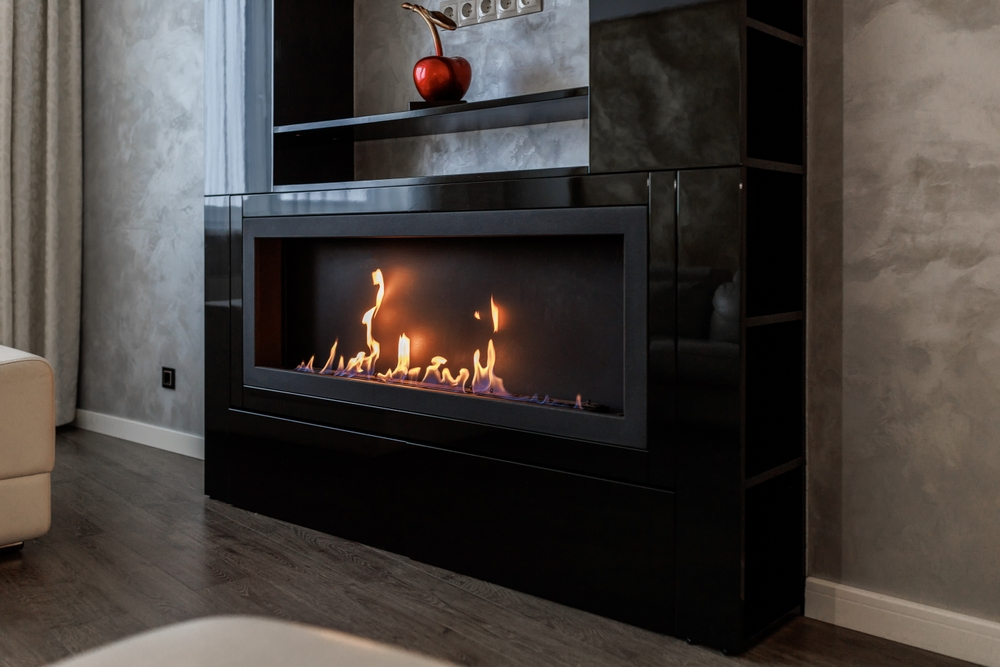Gas Fireplace Cleaning Pittsburgh
It can get cool in the winter or evening in Pittsburgh, Pennsylvania.
Did you know that your gas fireplace needs to be serviced every year to ensure safe operation?
If you are like most people you were unaware of this necessity.
It is recommended that a licensed service technician inspects your gas fireplace annually to ensure the safe, efficient, and reliable operation of your gas unit.
For the safety of your home, it is recommended that both gas fireplaces and wood-burning fireplaces including stove inserts and pellet stoves be serviced once a year. Any time you have a live-fire burning in your home you want to make sure everything is performing at optimal efficiency for safety and reliability.
Another thing to consider is that there is a higher risk of having a carbon monoxide issue due to parts wearing out if you do not get your fireplace inspected by a professional every year.
There are a lot of moving parts in gas fireplaces. Servicing those parts to make sure they have been adjusted appropriately and identifying when they need to be replaced will give you peace of mind when using your appliance. Those parts last longer when they are serviced on an annual basis saving you money in the long run.
If you don’t use your gas unit often there is a possibility of bugs and spiders in the venting living and spinning webs. This can cause issues with proper venting and can also be a factor in causing a carbon monoxide issue.
So even though gas fireplaces don’t cause creosote build up like in a wood-burning fireplace there can still be issues with parts needing to be replaced or adjusted. A yearly inspection is the best solution to keeping your family safe from carbon monoxide leaks due to unexpected failure of worn-out parts.
We offer gas fireplace repair and cleaning. Chimcare started years ago as a family-based business. Since then we have grown from one chimney sweep to a crew of licensed technicians offering you home solutions from fireplace inspection, cleaning, installation, and other related services.
Simply call to schedule an inspection in Pittsburgh for gas fireplace cleaning which will include the safety inspection. This service will give you peace of mind, save you money, and could save your life.
Facts About Pittsburgh
| Jan | Feb | Mar | Apr | May | Jun | |
|---|---|---|---|---|---|---|
| Average high in ºF | 37 | 40 | 50 | 62 | 71 | 79 |
| Average low in ºF | 21 | 22 | 30 | 39 | 51 | 61 |
| Av. precipitation in inch | 2.89 | 2.26 | 3.03 | 3.00 | 3.28 | 2.99 |
| Jul | Aug | Sep | Oct | Nov | Dec | |
|---|---|---|---|---|---|---|
| Average high in ºF | 83 | 82 | 75 | 64 | 53 | 41 |
| Average low in ºF | 66 | 63 | 55 | 44 | 34 | 25 |
| Av. precipitation in inch | 3.35 | 3.00 | 3.02 | 2.17 | 3.13 | 2.71 |
Source: https://www.usclimatedata.com/climate/pittsburgh/pennsylvania/united-states/uspa3601
At the 2010 Census, there were 305,704 people residing in Pittsburgh, a decrease of 8.6% since 2000. 66.0% of the population was White, 25.8% Black or African American, 0.2% American Indian and Alaska Native, 4.4% Asian, 0.3% Other, and 2.3% mixed. 2.3% of Pittsburgh’s population was of Hispanic or Latino origin of any race. Non-Hispanic Whites were 64.8% of the population in 2010,[103] compared to 78.7% in 1970.[104]
The five largest European ethnic groups in the city are German (19.7%), Irish (15.8%), Italian (11.8%), Polish (8.4%), and English (4.6%), while the metropolitan area is approximately 22% German-American, 15.4% Italian American and 11.6% Irish American. Pittsburgh has one of the largest Italian-American communities in the nation[106] and the fifth-largest Ukrainian community.[107] Pittsburgh has one of the most extensive Croatian communities in the United States.[108] Overall, the Pittsburgh Metro Area has one of the largest populations of Slavic Americans in the country.
Pittsburgh has a sizeable African American population, concentrated in various neighborhoods especially in the East End. There is also a small Asian community consisting of Indian immigrants, and a small Hispanic community consisting of Mexicans and Puerto Ricans.[109]
According to a 2010 Association of Religion Data Archives (ARDA) study, residents include 773,341 “Catholics”; 326,125 “Mainline Protestants”; 174,119 “Evangelical Protestants;” 20,976 “Black Protestants;” and 16,405 “Orthodox Christians,” with 996,826 listed as “unclaimed” and 16,405 as “other” in the metro area.[110] A 2017 study by the Cohen Center for Modern Jewish Studies at Brandeis University estimated the Jewish population of Greater Pittsburgh was 49,200.[111]
According to a 2014 study by the Pew Research Center, 78% of the population of the city identified themselves as Christians, with 42% professing attendance at a variety of churches that could be considered Protestant, and 32% professing Roman Catholic beliefs. while 18% claim no religious affiliation. The same study says that other religions (including Judaism, Buddhism, Islam, and Hinduism) collectively make up about 4% of the population.[112]
There were 143,739 households, out of which 21.9% had children under the age of 18 living with them, 31.2% were married couples living together, 16.5% had a female householder with no husband present, and 48.4% were non-families. 39.4% of all households were made up of individuals, and 13.7% had someone living alone who was 65 years of age or older. The average household size was 2.17 and the average family size was 2.95.
In the city, the population was spread out, with 19.9% under the age of 18, 14.8% from 18 to 24, 28.6% from 25 to 44, 20.3% from 45 to 64, and 16.4% who were 65 years of age or older. The median age was 36 years. For every 100 females, there were 90.7 males. For every 100 females age 18 and over, there were 87.8 males.
The median income for a household in the city was $28,588, and the median income for a family was $38,795. Males had a median income of $32,128 versus $25,500 for females. The per capita income for the city was $18,816. About 15.0% of families and 20.4% of the population were below the poverty line, including 27.5% of those under the age of 18 and 13.5% ages 65 or older.
In a 2002 study, Pittsburgh ranked 22nd of 69 urban places in the U.S. in the number of residents 25 years or older who had completed a bachelor’s degree, at 31%.[113] Pittsburgh ranked 15th of the 69 places in the number of residents 25 years or older who completed a high school degree, at 84.7%.[114]
The metro area has shown greater residential racial integration during the last 30 years. The 2010 census ranked 18 other U.S. metros as having greater black-white segregation, while 32 other U.S. metros rank higher for black-white isolation.[115]
Source: https://en.wikipedia.org/wiki/Pittsburgh#Demographics
Gas Fireplace FAQs – Pittsburgh, Pennsylvania
How often should my gas fireplace be inspected and cleaned?
Experts recommend a professional inspection and cleaning at least once per year—even gas fireplaces—because annual servicing helps identify issues like blocked vents, gas leaks, or draft problems. ()
What routine maintenance can I do myself?
You can dust logs, wipe the glass, vacuum the firebox, and test carbon‑monoxide detectors. Tasks like burner cleaning, vent inspections, gas-leak testing, and ignition system checks should be handled by certified technicians. ()
What does a professional service include?
A technician will inspect and clean burners, logs, and glass; tighten gas fittings; test ignition and flame sensors; inspect vents and chimney for obstructions (e.g., nests or soot buildup); and perform carbon‑monoxide safety checks. ()
What happens if I skip annual servicing?
Skipping yearly maintenance may lead to clogged burners, poor ignition, weak or yellow flames, gas leaks, vent blockages, or smoky combustion—compromising efficiency and creating safety hazards. ()
Why are carbon‑monoxide detectors essential near my fireplace?
Gas fireplaces can emit odorless, colorless carbon monoxide if combustion or venting malfunctions. CO detectors provide early warning and are required in homes with gas appliances in Pennsylvania. ()




 >
>
Leave a Reply